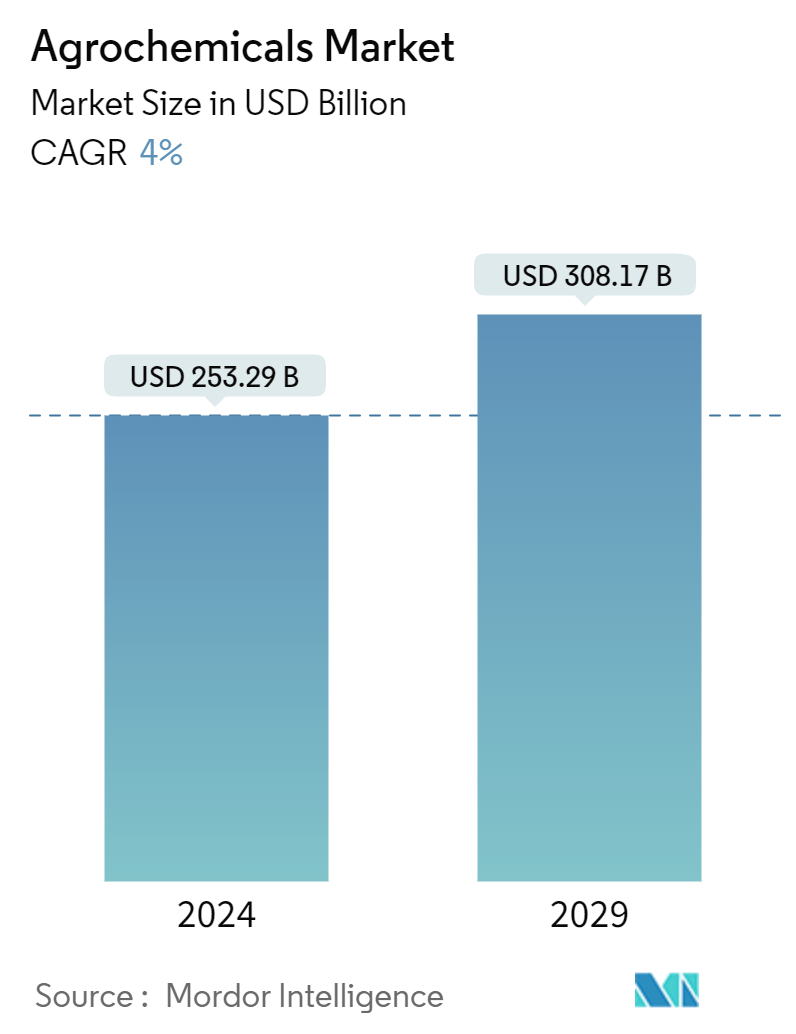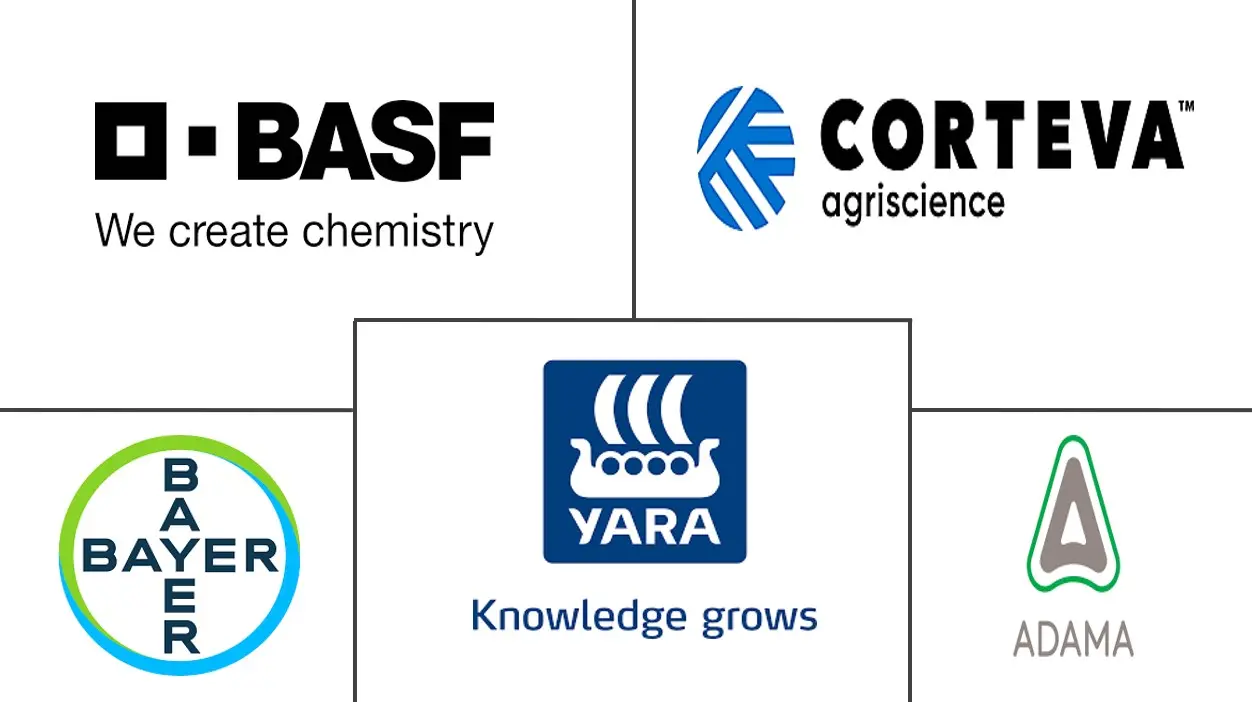Market Size of Agrochemicals Industry

| Study Period | 2019 - 2029 |
| Market Size (2024) | USD 253.29 Billion |
| Market Size (2029) | USD 308.17 Billion |
| CAGR (2024 - 2029) | 4.00 % |
| Fastest Growing Market | North America |
| Largest Market | Asia Pacific |
Major Players
*Disclaimer: Major Players sorted in no particular order |
Agrochemicals Market Analysis
The Agrochemicals Market size is estimated at USD 253.29 billion in 2024, and is expected to reach USD 308.17 billion by 2029, growing at a CAGR of 4% during the forecast period (2024-2029).
The rising population across the world, accompanied by rising affluence, is shifting consumption patterns. There is a need not just to increase production to meet demand but also to ensure that the nutritional needs of an increasingly affluent population are met. Moreover, the demand for healthy diets has increased the consumption of cereals, fruits, and vegetables across the world. This has resulted in integration among growers, federal governments, and industries to improve crop yield to meet global food supply requirements. While all this is done, proper care is applied so as not to cause any adverse effects on human safety and ecological balance.
For instance, according to the IMF, in 2021, the estimated total population in India amounted to approximately 1.39 billion people. According to the FAO, in 2021, 11.7% of the global population experienced severe food insecurity. Shrinking arable land and loss of crops due to pest attacks lead to wastage, posing a critical challenge to ensuring food and nutritional security. According to the US Department of Agriculture, from 2000 onwards, the total land area in the US farms has decreased annually. The total farmland area has decreased by almost 50 million acres, reaching 895.3 million acres as of 2021. Such factors are raising the demand for agrochemicals, which boosts agricultural output.
Agrochemical usage is mainly driven by the growing application of genetically modified crops, such as soybean, maize, and cotton. The increasing application of agrochemicals has increased the need for the availability and production of more inert ingredients in the world.
Moreover, insect pests, plant parasitic nematodes, and fungal diseases continuously evolve and attack plants, leading to decreased yields. Furthermore, the incidence of resistant pests and insects against the existing crop protection chemicals in recent years is leading to the development of new active ingredient agrochemicals, increasing disease incidences. For instance, clubroot is a serious soil-borne disease of cruciferous plants, such as canola. In canola, swellings or galls form on the roots, which can ultimately cause premature death of the plant. About 300 new fields a year in Alberta have been found to have clubroot, and cases have started to spring up in Manitoba and Saskatchewan, Canada’s largest canola growers. There are about 3,000 fields infected with clubroot in Canada, which could devastate the Canadian canola industry. However, there is rampant crop damage due to disease incidence, causing enormous losses to economically important crops. This created the need to develop new fungicides and compelled farmers to adopt an intensified application of agrochemicals such as fungicides and insecticides.
However, regulatory restrictions and environmental concerns are the major factors that can restrain the use of raw materials in agrochemicals. Government regulations and restrictions on using certain raw materials can limit their availability and use in crop protection. For instance, in December 2021, the Government of Mexico passed a decree to eliminate the use of glyphosate-based pesticide products in the country. More pesticides are projected to be eliminated in the coming years amid rising consumer awareness about the impact of pesticides on human and environmental health.
Agrochemicals Industry Segmentation
Agrochemicals are used to prevent the deterioration of crops from insects and pest infestation and disease. The agrochemicals market report offers the latest trends, growth factors, industry competitiveness, investment opportunities, and a detailed profile of the top players in the market.
The agrochemicals market is segmented by product type (fertilizers, pesticides, adjuvants, and plant growth regulators ), application (crop-based and non-crop-based), and geography (North America, Europe, Asia-Pacific, South America, and Africa). The report offers market size and forecasts for the market in terms of value in USD for all the above segments.
| Product Type | |
| Fertilizers | |
| Pesticides | |
| Adjuvants | |
| Plant Growth Regulators |
| Application | |||||
| |||||
|
| Geography | |||||||||
| |||||||||
| |||||||||
| |||||||||
| |||||||||
|
Agrochemicals Market Size Summary
The agrochemical industry is poised for steady growth, driven by the increasing global demand for food due to population growth and changing consumption patterns. As the world population continues to rise, there is a pressing need to enhance agricultural productivity to meet the nutritional needs of an affluent society. This has led to a surge in the use of agrochemicals, which play a crucial role in boosting crop yields and ensuring food security. The integration of genetically modified crops and the development of new active ingredients in agrochemicals are key trends shaping the market. However, challenges such as shrinking arable land, pest attacks, and environmental concerns pose significant hurdles. Regulatory restrictions on certain raw materials and a growing emphasis on sustainable practices are influencing the market dynamics, prompting a shift towards organic and environmentally friendly solutions.
The market is characterized by a fragmented landscape with major players like Bayer Crop Science AG, Adama Agricultural Solutions, and BASF SE leading the charge through strategic initiatives such as mergers, acquisitions, and product launches. The demand for fertilizers, particularly nitrogen, phosphorus, and potassium (NPK) fertilizers, is on the rise as they are essential for enhancing crop productivity. Despite the growth in fertilizer consumption, there remains a significant gap between demand and supply, especially in regions like India, which heavily relies on imports to meet its needs. The market is also witnessing increased investment in research and development to address challenges such as pest resistance and crop diseases. As governments and industries collaborate to improve agricultural output while maintaining ecological balance, the agrochemical industry is expected to continue its upward trajectory, supported by innovations and strategic partnerships.
Agrochemicals Market Size - Table of Contents
-
1. MARKET DYNAMICS
-
1.1 Market Overview
-
1.2 Market Drivers
-
1.2.1 Increasing Demand for Food Due to High Population Growth
-
1.2.2 Adoption of Sustainable Farming Practices
-
1.2.3 Need for Increased Land Productivity
-
-
1.3 Market Restraints
-
1.3.1 Environmental and Regulatory Constraints
-
1.3.2 Increased Cost and Difficulty with Product Development
-
-
1.4 Industry Attractiveness - Porter's Five Forces Analysis
-
1.4.1 Bargaining Power of Suppliers
-
1.4.2 Bargaining Power of Buyers
-
1.4.3 Threat of New Entrants
-
1.4.4 Threat of Substitute Products
-
1.4.5 Intensity of Competitive Rivalry
-
-
-
2. MARKET SEGMENTATION
-
2.1 Product Type
-
2.1.1 Fertilizers
-
2.1.2 Pesticides
-
2.1.3 Adjuvants
-
2.1.4 Plant Growth Regulators
-
-
2.2 Application
-
2.2.1 Crop-based
-
2.2.1.1 Grains and Cereals
-
2.2.1.2 Pulses and Oilseeds
-
2.2.1.3 Fruits and Vegetables
-
-
2.2.2 Non-crop-based
-
2.2.2.1 Turf and Ornamental Grass
-
2.2.2.2 Other Non-crop-based
-
-
-
2.3 Geography
-
2.3.1 North America
-
2.3.1.1 United States
-
2.3.1.2 Canada
-
2.3.1.3 Mexico
-
2.3.1.4 Rest of North America
-
-
2.3.2 Europe
-
2.3.2.1 Spain
-
2.3.2.2 United Kingdom
-
2.3.2.3 France
-
2.3.2.4 Germany
-
2.3.2.5 Russia
-
2.3.2.6 Italy
-
2.3.2.7 Rest of Europe
-
-
2.3.3 Asia-Pacific
-
2.3.3.1 China
-
2.3.3.2 India
-
2.3.3.3 Japan
-
2.3.3.4 Australia
-
2.3.3.5 Rest of Asia Pacific
-
-
2.3.4 South America
-
2.3.4.1 Brazil
-
2.3.4.2 Argentina
-
2.3.4.3 Rest of South America
-
-
2.3.5 Africa
-
2.3.5.1 South Africa
-
2.3.5.2 Rest of Africa
-
-
-
Agrochemicals Market Size FAQs
How big is the Agrochemicals Market?
The Agrochemicals Market size is expected to reach USD 253.29 billion in 2024 and grow at a CAGR of 4% to reach USD 308.17 billion by 2029.
What is the current Agrochemicals Market size?
In 2024, the Agrochemicals Market size is expected to reach USD 253.29 billion.

